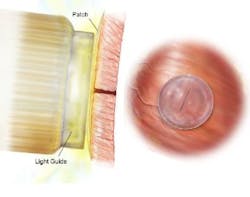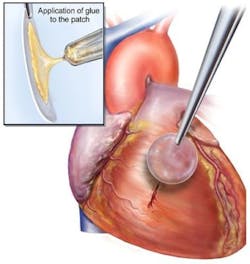Bio-inspired, light-activated glue could fix heart defects
A team of researchers from Boston Children's Hospital, Brigham and Women's Hospital (BWH), and the Massachusetts Institute of Technology (MIT; all in Boston, MA) has developed a bio-inspired, ultraviolet (UV) light-activated adhesive that could rapidly attach biodegradable patches inside a beating heart--in the exact place where congenital holes in the heart occur, such as with ventricular heart defects.
Related: Photoactivatable bio-adhesive outperforms sutures for delicate operations
When a child is born with a heart defect such as a hole in the heart, highly invasive therapies are challenging due to an inability to quickly and safely secure devices inside the heart. Sutures take too much time to stitch and can cause stress on fragile heart tissue, and currently available clinical adhesives are either too toxic or tend to lose their sticking power in the presence of blood or under dynamic conditions, such as in a beating heart.
"About 40,000 babies are born with congenital heart defects in the United States annually, and those that require treatment are plagued with multiple surgeries to deliver or replace non-degradable implants that do not grow with young patients," says Jeffrey Karp, Ph.D., Division of Biomedical Engineering, BWH Department of Medicine, and co-senior study author.
Recognizing that many creatures in nature have secretions that are viscous and repel water, enabling them to attach under wet and dynamic conditions, the researchers developed a material with these properties that also is biodegradable, elastic, and biocompatible. According to the study authors, the degradable patches secured with the glue remained attached even at increased heart rates and blood pressure.
"This adhesive platform addresses all of the drawbacks of previous systems in that it works in the presence of blood and moving structures," says Pedro del Nido, MD, Chief of Cardiac Surgery, Boston Children's Hospital, co-senior study author. "It should provide the physician with a completely new, much simpler technology and a new paradigm for tissue reconstruction to improve the quality of life of patients following surgical procedures."
Unlike current surgical adhesives, this new adhesive maintains very strong sticking power when in the presence of blood, and even in active environments.
"This study demonstrated that the adhesive was strong enough to hold tissue and patches onto the heart equivalent to suturing," says the study's co-first author Nora Lang, MD, Department of Cardiac Surgery, Boston Children's Hospital. "Also, the adhesive patch is biodegradable and biocompatible, so nothing foreign or toxic stays in the bodies of these patients."
Importantly, its adhesive abilities are activated with UV light, providing an on-demand, anti-bleeding seal within five seconds of UV light application when applied to high-pressure large blood vessels and cardiac wall defects.
"When we attached patches coated with our adhesive to the walls of a beating heart, the patches remained despite the high pressures of blood flowing through the heart and blood vessels," says Maria N. Pereira, PhD, Division of Biomedical Engineering, BWH Department of Medicine, co-first study author.
The researchers note that their waterproof, light-activated adhesive will be useful in reducing the invasiveness of surgical procedures, as well as operating times, in addition to improving heart surgery outcomes.
The adhesive technology (and other related platforms) has been licensed to a start-up company, Gecko Biomedical (Paris, France). The company has raised $10.8 million (â¬8 million) in their recently announced Series A financing round and expects to bring the adhesive to the market within two to three years.
Full details of the study appear in Science Translational Medicine; for more information, please visit http://stm.sciencemag.org/content/6/218/218ra6.
-----
Follow us on Twitter, 'like' us on Facebook, and join our group on LinkedIn
Subscribe now to BioOptics World magazine; it's free!


